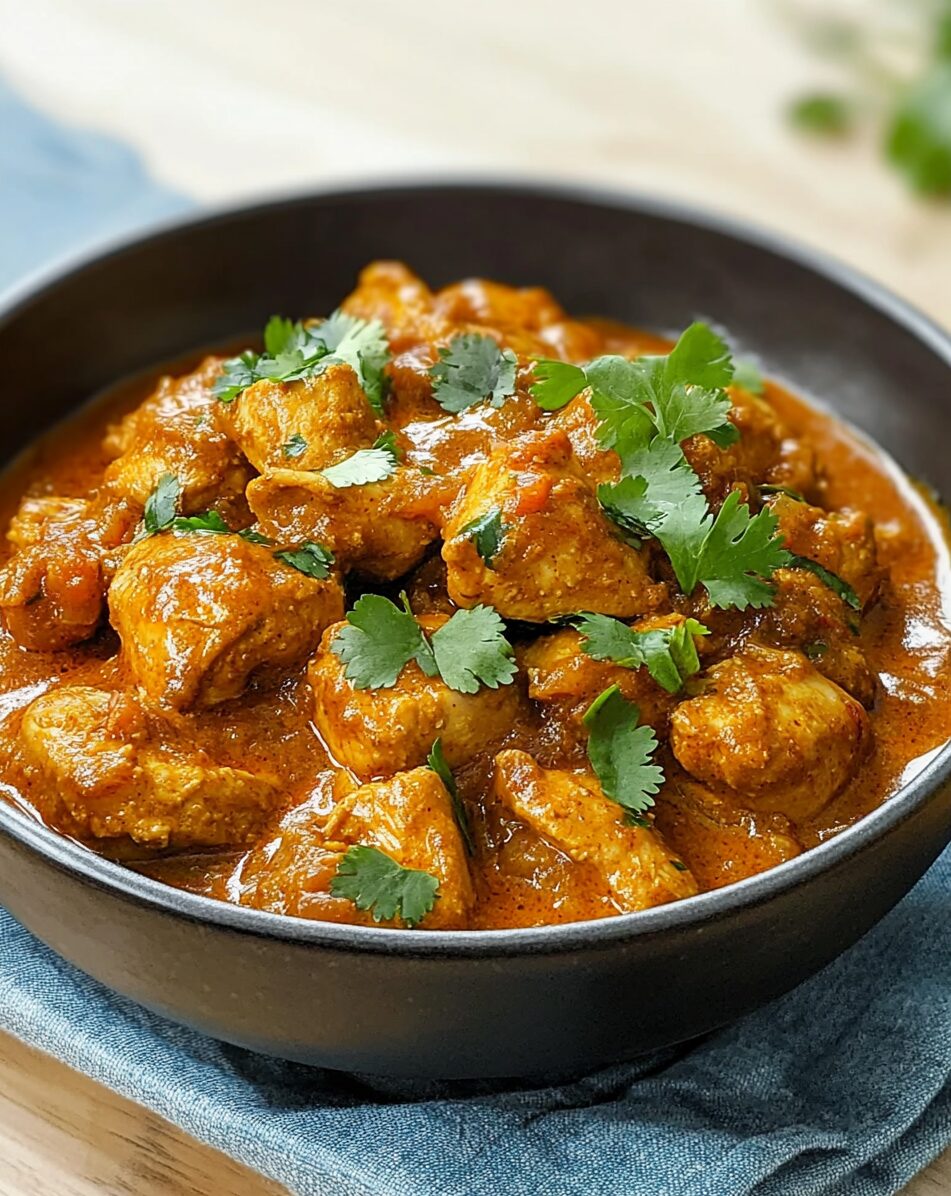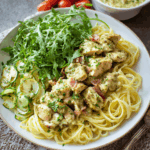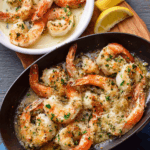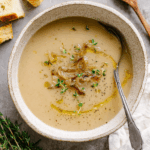Full Recipe
- 2 tablespoons vegetable oil
- 1 large onion, finely chopped
- 2 cloves garlic, minced
- 1 tablespoon grated fresh ginger
- 2 teaspoons ground cumin
- 2 teaspoons ground coriander
- 1 teaspoon ground turmeric
- 1 teaspoon ground cayenne pepper (adjust for heat preference)
- 1 tablespoon curry powder
- 1 (14.5-ounce) can diced tomatoes
- 1 (15-ounce) can coconut milk
- 1 cup plain yogurt
- 1 tablespoon tomato paste
- 1 tablespoon lemon juice
- Salt and pepper to taste
- 4 skinless, boneless chicken breast halves, cut into bite-sized pieces
- 2 tablespoons chopped fresh cilantro for garnish
Directions:
- Heat the Oil: In a large skillet, heat the vegetable oil over medium heat. Add the chopped onion, garlic, and ginger, and sauté for 5 minutes until the onion is soft and golden.
- Add the Spices: Stir in the cumin, coriander, turmeric, cayenne pepper, and curry powder. Cook for another 2-3 minutes to release the aromatic flavors of the spices.
- Incorporate the Wet Ingredients: Add the diced tomatoes, coconut milk, yogurt, tomato paste, and lemon juice. Stir the mixture to combine well, then season with salt and pepper to taste.
- Simmer with Chicken: Add the chicken pieces into the skillet and stir to coat them evenly with the sauce. Bring the mixture to a simmer. Reduce the heat, cover, and let it cook for 20-25 minutes, or until the chicken is cooked through and tender.
- Final Touches: Adjust the seasoning as needed, and garnish with fresh cilantro.
Prep Time: 15 minutes | Cooking Time: 30 minutes | Total Time: 45 minutes
Servings: 4 servings | Kcal: Approximately 350 kcal per serving
Tips for Perfecting Your Indian Chicken Curry
- Use Fresh Spices: The key to a flavorful curry is using fresh, high-quality spices. Ground spices lose their potency over time, so make sure yours are fresh to ensure the curry has the depth of flavor it deserves.
- Marinate the Chicken: To enhance the flavor and tenderness of the chicken, consider marinating it in yogurt, turmeric, and a pinch of salt for 30 minutes before cooking. This not only adds flavor but helps to keep the chicken moist and tender.
- Cook Spices Slowly: When sautéing the spices with onions, garlic, and ginger, be sure to cook them on medium heat and not rush the process. This step is crucial as it allows the spices to release their oils and infuse the dish with rich, aromatic flavors.
- Adjust the Consistency: If you like a thicker curry, reduce the sauce by simmering it longer without the lid. For a thinner, more stew-like consistency, add a little water or extra coconut milk to the curry while it cooks.
Nutritional Benefits:
Indian Chicken Curry is a protein-packed dish with rich and aromatic spices, offering both flavor and health benefits.
- Chicken: A great source of lean protein, supporting muscle growth and repair. It is also rich in vitamins like B6, which helps maintain energy levels, and minerals like selenium and phosphorus.
- Spices (Turmeric, Cumin, Coriander, and Garam Masala): These spices provide anti-inflammatory and antioxidant properties. Turmeric, in particular, is known for its active compound curcumin, which aids in reducing inflammation and boosting immunity.
- Onions, Garlic, and Ginger: These foundational ingredients in Indian cuisine are full of antioxidants, help improve digestion, and support the immune system.
- Tomatoes: Packed with vitamin C, potassium, and lycopene, tomatoes offer heart-healthy benefits and promote skin health.
A Deep Dive into Indian Chicken Curry
Flavor Profile: Indian Chicken Curry II features a rich and complex flavor profile that blends earthy spices with a creamy sauce. The base of this dish is built from a combination of onion, garlic, and ginger, sautéed to release their sweet and savory notes. The spice mix—featuring cumin, coriander, turmeric, cayenne pepper, and curry powder—brings a balance of warmth, heat, and earthy depth to the curry. Coconut milk and yogurt are added to give the sauce a creamy texture, creating a perfect harmony between richness and spice.
The beauty of Indian curries lies in the layers of flavor that develop as the spices cook, each contributing to the overall taste in a unique way. In this dish, the tangy tomatoes and the slight acidity from lemon juice brighten the dish, while the yogurt adds a subtle tang and richness.
Customizable and Adaptable: This curry is highly adaptable depending on your preferences:
- Spice Level: If you prefer a milder curry, reduce the amount of cayenne pepper. For those who enjoy more heat, add a touch more or include fresh green chilies.
- Vegetarian Option: You can easily make this recipe vegetarian by substituting the chicken with tofu, paneer (Indian cheese), or mixed vegetables like cauliflower and potatoes.
- Additional Flavors: You can enhance the dish further by adding a pinch of garam masala towards the end of cooking for an extra burst of aromatic spices. For a more luxurious touch, stir in a spoonful of heavy cream before serving.
Serving Suggestions: Indian Chicken Curry II pairs perfectly with basmati rice, which absorbs the rich sauce. Alternatively, it can be served with naan bread or roti, allowing you to scoop up every last bit of the flavorful curry. A side of cooling raita (a yogurt-based condiment with cucumber or mint) and mango chutney can also balance out the heat and spice.
Storage and Meal Prep: This curry makes an excellent meal for batch cooking. The flavors often deepen and improve after a day or two, making it a great dish to prepare in advance for busy weeknights. It stores well in the refrigerator for up to 3 days and can also be frozen for longer periods. Just reheat on the stove or in the microwave and add a little water if the sauce thickens too much.
Cultural Importance of Indian Curries
Indian curries, including chicken curry, are an integral part of Indian cuisine, reflecting the country’s diverse culinary traditions. Each region of India has its own version of curry, with variations in the choice of spices, the inclusion of coconut milk, or the method of preparation. For example:
- Northern India: Creamier curries, often made with yogurt or cream, are popular, such as in Punjabi-style chicken curry.
- Southern India: Curries here often incorporate coconut milk, tamarind, and curry leaves, resulting in more tangy, aromatic flavors.
- Eastern India: Mustard oil and seeds are often used in the curries, giving the dishes a distinctive, sharp flavor.
- Western India: Curries tend to be spicy and bold, featuring a variety of dried red chilies and garam masala blends.
Chicken curry is a universally loved dish throughout India and has become a symbol of comfort and tradition in Indian households. It’s often served during family gatherings, festivals, and special occasions, with each family having its own treasured recipe.
History and Origin:
Indian Chicken Curry is rooted in the culinary traditions of the Indian subcontinent. “Curry” is a term used by British colonists to describe a variety of dishes prepared with a complex blend of spices. The word itself comes from “kari,” meaning sauce in Tamil.
Chicken curry is one of the most beloved dishes across India, with regional variations in spice blends, preparation methods, and ingredients. For example, in northern India, curries often include dairy like yogurt or cream, while southern Indian curries are coconut-based. Indian Chicken Curry II reflects a traditional approach, with influences from different regions that make the dish aromatic and deeply flavorful.






